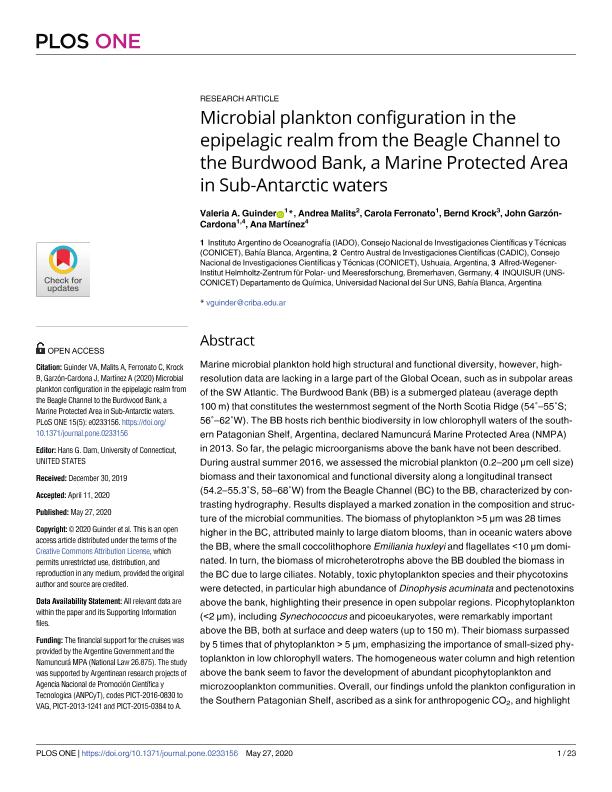Mostrar el registro sencillo del ítem
dc.contributor.author
Guinder, Valeria Ana

dc.contributor.author
Malits, Andrea

dc.contributor.author
Ferronato, Carola

dc.contributor.author
Krock, Bernd

dc.contributor.author
Garzon Cardona, John Edison

dc.contributor.author
Martínez, Ana
dc.date.available
2021-09-23T12:07:32Z
dc.date.issued
2020-05
dc.identifier.citation
Guinder, Valeria Ana; Malits, Andrea; Ferronato, Carola; Krock, Bernd; Garzon Cardona, John Edison; et al.; Microbial plankton configuration in the epipelagic realm from the Beagle Channel to the Burdwood Bank, a Marine Protected Area in Sub-Antarctic waters; Public Library of Science; Plos One; 15; 5; 5-2020; 1-23
dc.identifier.issn
1932-6203
dc.identifier.uri
http://hdl.handle.net/11336/141291
dc.description.abstract
Marine microbial plankton hold high structural and functional diversity, however, highresolution data are lacking in a large part of the Global Ocean, such as in subpolar areas of the SW Atlantic. The Burdwood Bank (BB) is a submerged plateau (average depth 100 m) that constitutes the westernmost segment of the North Scotia Ridge (54°-55°S; 56°-62°W). The BB hosts rich benthic biodiversity in low chlorophyll waters of the southern Patagonian Shelf, Argentina, declared NamuncuráMarine Protected Area (NMPA) in 2013. So far, the pelagic microorganisms above the bank have not been described. During austral summer 2016, we assessed the microbial plankton (0.2-200 μm cell size) biomass and their taxonomical and functional diversity along a longitudinal transect (54.2-55.3°S, 58-68°W) from the Beagle Channel (BC) to the BB, characterized by contrasting hydrography. Results displayed a marked zonation in the composition and structure of the microbial communities. The biomass of phytoplankton >5 μm was 28 times higher in the BC, attributed mainly to large diatom blooms, than in oceanic waters above the BB, where the small coccolithophore Emiliania huxleyi and flagellates <10 μm dominated. In turn, the biomass of microheterotrophs above the BB doubled the biomass in the BC due to large ciliates. Notably, toxic phytoplankton species and their phycotoxins were detected, in particular high abundance of Dinophysis acuminata and pectenotoxins above the bank, highlighting their presence in open subpolar regions. Picophytoplankton (<2 μm), including Synechococcus and picoeukaryotes, were remarkably important above the BB, both at surface and deep waters (up to 150 m). Their biomass surpassed by 5 times that of phytoplankton > 5 μm, emphasizing the importance of small-sized phytoplankton in low chlorophyll waters. The homogeneous water column and high retention above the bank seem to favor the development of abundant picophytoplankton and microzooplankton communities. Overall, our findings unfold the plankton configuration in the Southern Patagonian Shelf, ascribed as a sink for anthropogenic CO2, and highlight the diverse ecological traits that microorganisms develop to adjust their yield to changing conditions.
dc.format
application/pdf
dc.language.iso
eng
dc.publisher
Public Library of Science

dc.rights
info:eu-repo/semantics/openAccess
dc.rights.uri
https://creativecommons.org/licenses/by-nc-sa/2.5/ar/
dc.subject
Microbial diversity
dc.subject
funcional groups
dc.subject
Beagle Channel
dc.subject
Namuncurá Marine Protected Area
dc.subject.classification
Oceanografía, Hidrología, Recursos Hídricos

dc.subject.classification
Ciencias de la Tierra y relacionadas con el Medio Ambiente

dc.subject.classification
CIENCIAS NATURALES Y EXACTAS

dc.title
Microbial plankton configuration in the epipelagic realm from the Beagle Channel to the Burdwood Bank, a Marine Protected Area in Sub-Antarctic waters
dc.type
info:eu-repo/semantics/article
dc.type
info:ar-repo/semantics/artículo
dc.type
info:eu-repo/semantics/publishedVersion
dc.date.updated
2021-08-19T20:01:33Z
dc.journal.volume
15
dc.journal.number
5
dc.journal.pagination
1-23
dc.journal.pais
Estados Unidos

dc.description.fil
Fil: Guinder, Valeria Ana. Consejo Nacional de Investigaciones Científicas y Técnicas. Centro Científico Tecnológico Conicet - Bahía Blanca. Instituto Argentino de Oceanografía. Universidad Nacional del Sur. Instituto Argentino de Oceanografía; Argentina
dc.description.fil
Fil: Malits, Andrea. Consejo Nacional de Investigaciones Científicas y Técnicas. Centro Austral de Investigaciones Científicas; Argentina
dc.description.fil
Fil: Ferronato, Carola. Consejo Nacional de Investigaciones Científicas y Técnicas. Centro Científico Tecnológico Conicet - Bahía Blanca. Instituto Argentino de Oceanografía. Universidad Nacional del Sur. Instituto Argentino de Oceanografía; Argentina
dc.description.fil
Fil: Krock, Bernd. Alfred-Wegener-Institut, Helmholtz-Zentrum für Polar- und Meeresforschung; Alemania
dc.description.fil
Fil: Garzon Cardona, John Edison. Consejo Nacional de Investigaciones Científicas y Técnicas. Centro Científico Tecnológico Conicet - Bahía Blanca. Instituto de Química del Sur. Universidad Nacional del Sur. Departamento de Química. Instituto de Química del Sur; Argentina
dc.description.fil
Fil: Martínez, Ana. Consejo Nacional de Investigaciones Científicas y Técnicas. Centro Científico Tecnológico Conicet - Bahía Blanca. Instituto de Química del Sur. Universidad Nacional del Sur. Departamento de Química. Instituto de Química del Sur; Argentina
dc.journal.title
Plos One

dc.relation.alternativeid
info:eu-repo/semantics/altIdentifier/url/https://journals.plos.org/plosone/article?id=10.1371/journal.pone.0233156
dc.relation.alternativeid
info:eu-repo/semantics/altIdentifier/doi/http://dx.doi.org/10.1371/journal.pone.0233156
Archivos asociados
